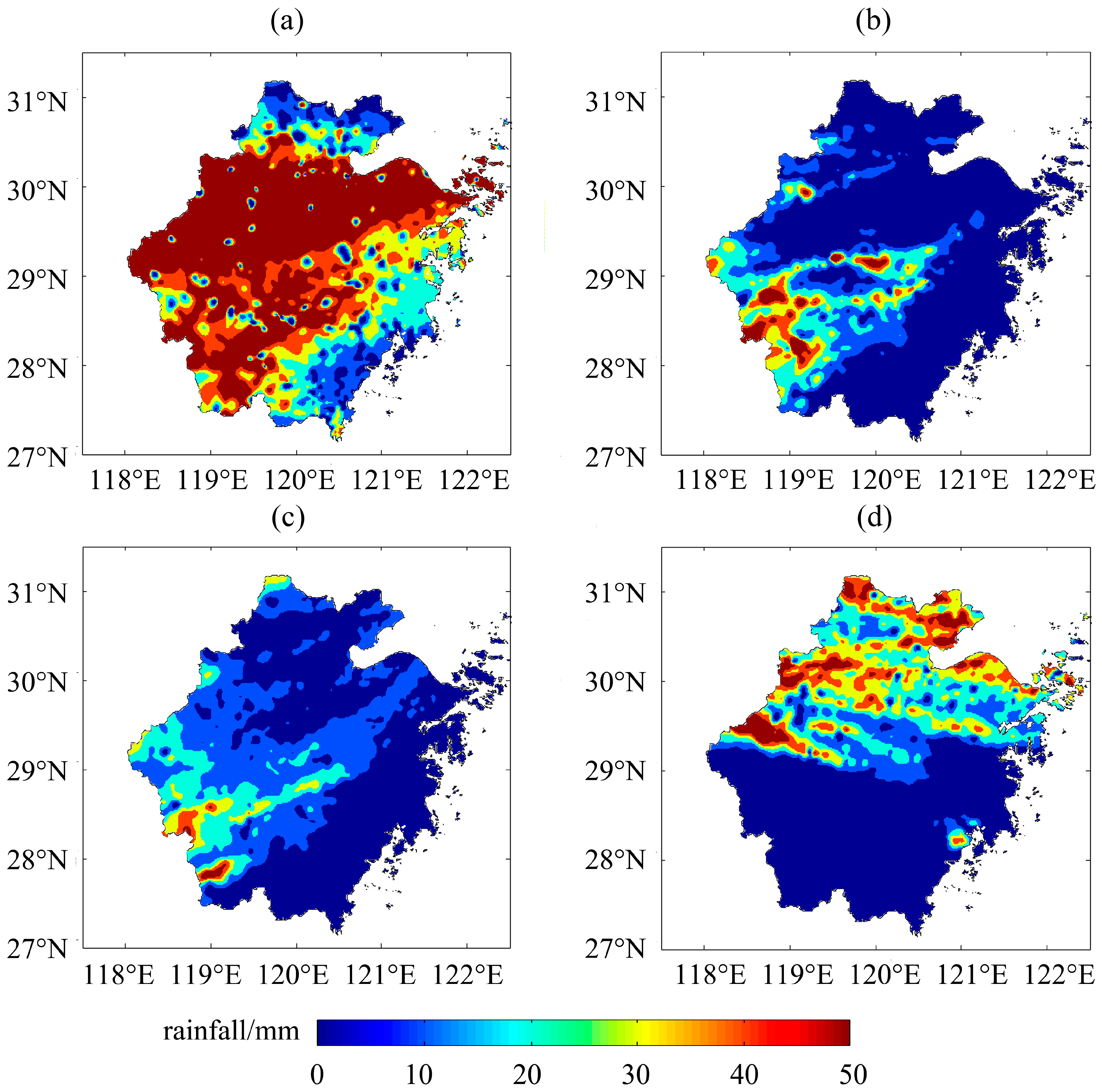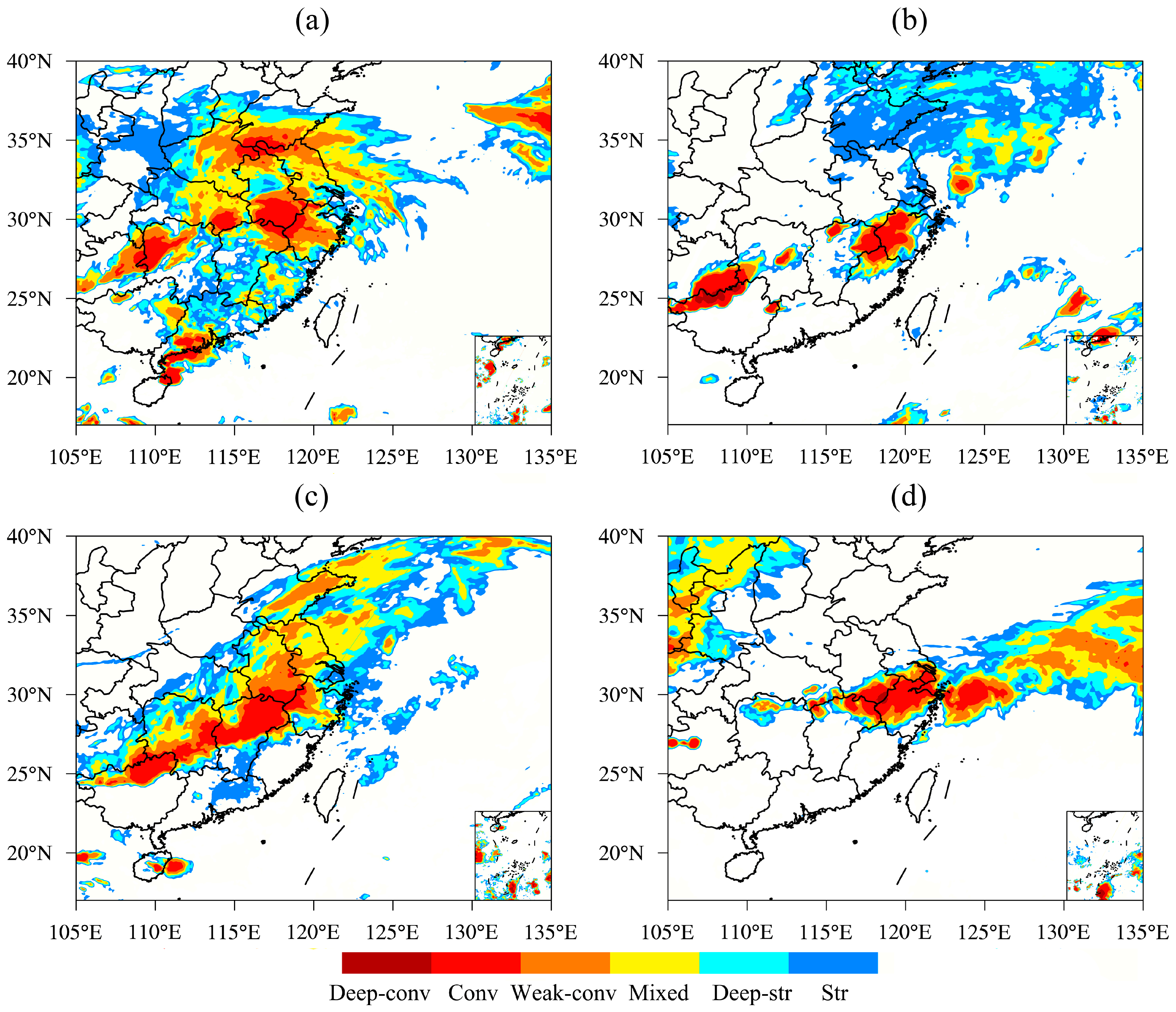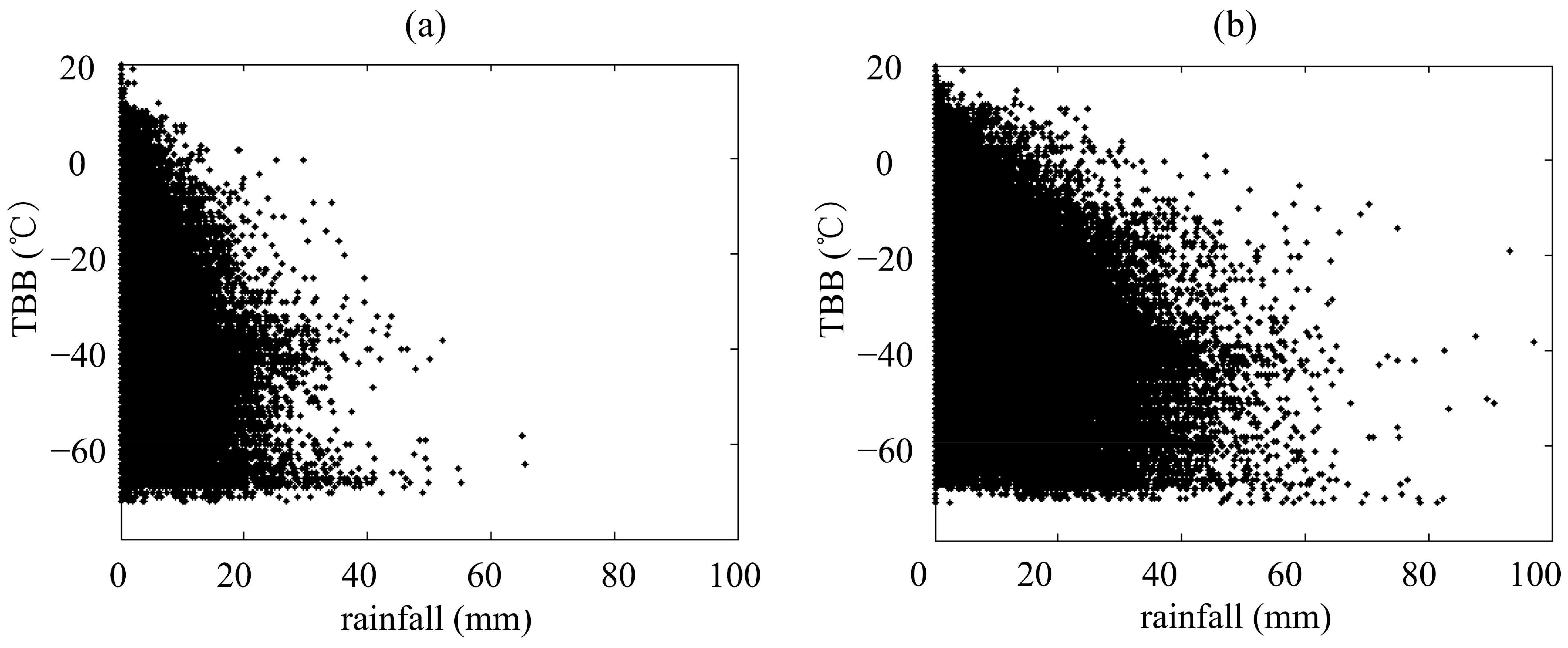Application of FY Satellite Data in Precipitation of Eastward-Moving Southwest China Vortex: A Case Study of Precipitation in Zhejiang Province
Abstract
:1. Introduction
2. Materials and Methods
3. Application of FY-2F Satellite Data
3.1. Spatial Differences in Precipitation
3.2. Discrimination of Precipitation Cloud Types
3.3. Quantitative Precipitation Application
4. Conclusions
- The variations in the intensity and position of the eastward-moving SWV often result in significant differences in precipitation intensity and distribution. Localized precipitation dominates in the SWV that affects Zhejiang, resulting in heavy rainfall and long duration. The SWV with convective precipitation as the main type often has multiple precipitation centers. The stronger the southwest vortex, the stronger and wider the development of convective clouds near the center, with stratiform or stratocumulus clouds dominating in the periphery. The center and southeast quadrant of the vortex are dominated by cumulonimbus and dense cirrus clouds, with high cloud-top heights and heavy precipitation, mainly in the form of convective precipitation. Other quadrants are dominated by stratiform or stratocumulus clouds, resulting in stable precipitation with lower rainfall amounts.
- The infrared brightness temperature threshold method can effectively identify cloud types within the SWV, providing an important reference for precipitation forecasting. When the TBB is below −70 °C (indicating deep convective clouds), both the forecast and observations indicate severe rainstorms. When the TBB is between −70 °C and −50 °C (indicating convective clouds), both the forecast and observations indicate heavy rainfall. Therefore, the TBB threshold method shows good predictive performance for forecasting moderate rain, heavy rain, and extremely heavy rain, based on the classification of thick cloud, convective cloud, and deep convective cloud. However, it tends to overestimate the precipitation for mixed clouds (forecasting heavy rain as severe rain) and underestimate the precipitation for stratiform clouds (forecasting moderate rain as light rain).
- There are significant differences in precipitation amounts produced by different cloud types, but a rough estimation can be made through a combination of qualitative and quantitative analysis. The different cloud types classified based on the TBB threshold show significant differences in precipitation within Zhejiang province. It is challenging to accurately forecast short-term precipitation. Deep convective clouds have the largest dispersion, with an average precipitation of 11 mm and 30 mm for 1 h and 3 h periods, respectively. Estimating short-term precipitation for different processes requires the use of other precipitation observation products for comprehensive analysis. Stratiform clouds have the smallest dispersion and the least precipitation, with the least variability. Under the assumption that cloud systems remain unchanged in the short term, the precipitation amounts produced by different cloud types can be roughly estimated.
Author Contributions
Funding
Institutional Review Board Statement
Informed Consent Statement
Data Availability Statement
Acknowledgments
Conflicts of Interest
References
- Wang, Q.W.; Tan, Z.M. Multi-scale topographic control of southwest vortex formation in Tibetan Plateau region in an idealized simulation. J. Geophys. Res. Atmos. 2014, 119, 11543–11561. [Google Scholar] [CrossRef]
- Wu, G.X.; Chen, S.J. The effect of mechanical forcing on the formation of a mesoscal vortex. Q. J. R. Meteorol. Soc. 1985, 111, 1049–1070. [Google Scholar] [CrossRef]
- Li, L.; Zhang, R.H. Evolution mechanisms, impacts, and variations of the vortices originated from the Tibetan Plateau. Earth-Sci. Rev. 2023, 242, 104463. [Google Scholar] [CrossRef]
- Feng, X.Y.; Liu, C.H.; Fan, G.Z.; Liu, X.D.; Feng, C.Y. Climatology and Structures of Southwest Vortices in NCEP Climate Forecast System Reanalysis. J. Clim. 2016, 29, 7675–7701. [Google Scholar] [CrossRef]
- Fu, S.M.; Li, W.L.; Sun, J.H.; Zhang, J.P.; Zhang, Y.C. Universal evolution mechanisms and energy conversion characteristics of long-lived mesoscale vortices over the Sichuan Basin. Atmos. Sci. Lett. 2015, 16, 127–134. [Google Scholar] [CrossRef]
- Yu, S.H.; Gao, W.L.; Xiao, D.X.; Peng, J. Observational facts regarding the joint activities of the southwest vortex and plateau vortex after its departure from the Tibetan Plateau. Adv. Atmos. Sci. 2016, 33, 34–46. [Google Scholar] [CrossRef]
- Li, G.P.; Chen, J. New progresses in the research of heavy rain vortices formed over the southwest China. Torrential Rain Disasters 2018, 37, 293–302. (In Chinese) [Google Scholar] [CrossRef]
- Ma, X.D.; Zhi, X.F.; Wang, J.; Chen, J.; Feng, H.Z. Analysis of the Southwest Vortex activities in summer and their relationship with precipitation during the period of 1979–2016. Trans. Atmos. Sci. 2018, 41, 198–206. (In Chinese) [Google Scholar] [CrossRef]
- Li, J.; Chen, H.M.; Rong, X.Y.; Su, J.Z.; Xin, Y.F.; Furtado, K.; Milton, S.; Li, N. How Well Can a Climate Model Simulate an Extreme Precipitation Event: A Case Study Using the Transpose-AMIP Experiment. J. Clim. 2018, 31, 6543–6556. [Google Scholar] [CrossRef]
- Chen, Y.R.; Li, Y.Q.; Zhao, T.L. Cause Analysis on Eastward Movement of Southwest China Vortex and Its Induced Heavy Rainfall in South China. Adv. Meteorol. 2015, 2015, 481735. [Google Scholar] [CrossRef]
- Luo, Y.L.; Wu, M.W.; Ren, F.M.; Li, J.; Wong, W.K. Synoptic Situations of Extreme Hourly Precipitation over China. J. Clim. 2016, 29, 8703–8719. [Google Scholar] [CrossRef]
- Xiang, S.Y.; Li, Y.Q.; Li, D.; Yang, S. An analysis of heavy precipitation caused by a retracing plateau vortex based on TRMM data. Meteor. Atmos. Phys. 2013, 122, 33–45. [Google Scholar] [CrossRef]
- Fu, S.M.; Tang, H.; Sun, J.H.; Zhao, T.B.; Li, W.L. Historical rankings and vortices’ activities of the extreme Mei-yu seasons: Contrast 2020 to previous Mei-yu seasons. Geophys. Res. Lett. 2022, 49, e2021GL096590. [Google Scholar] [CrossRef]
- Liu, H.S.; Huang, X.G.; Fei, J.F.; Zhang, C.; Cheng, X.P. Spatiotemporal features and associated synoptic patterns of extremely persistent heavy rainfall over China. J. Geophys. Res.-Atmos. 2022, 127, e2022JD036604. [Google Scholar] [CrossRef]
- Li, Y.Q.; Li, D.J.; Yang, S.; Liu, C.; Zhong, A.H. Characteristics of the precipitation over the eastern edge of the Tibetan Plateau. Meteor. Atmos. Phys. 2010, 106, 49–56. [Google Scholar] [CrossRef]
- Shou, Y.X.; Lu, F.; Liu, H.; Cui, P.; Shou, S.W.; Liu, J. Satellite-based Observational Study of the Tibetan Plateau Vortex: Features of Deep Convective Cloud Tops. Adv. Atmos. Sci. 2019, 36, 189–205. [Google Scholar] [CrossRef]
- Yu, Z.F. Physical and Optical Properties of Clouds in the Southwest Vortex from FY-4A Cloud Retrievals. J. Appl. Meteorol. Clim. 2022, 61, 1123–1138. [Google Scholar] [CrossRef]
- Wang, H.; Tan, L.Y.; Zhang, F.G.; Zheng, J.F.; Liu, Y.X.; Zeng, Q.Y.; Yan, Y.L.; Ren, X.Y.; Xiang, J. Three-Dimensional Structure Analysis and Droplet Spectrum Characteristics of Southwest Vortex Precipitation System Based on GPM-DPR. Remote Sens. 2022, 14, 4063. [Google Scholar] [CrossRef]
- Xiang, S.Y.; Li, Y.Q.; Zhai, S.X.; Peng, J. Comparative analysis of precipitation structures in two Southwest China Vortex events over eastern Sichuan Basin by TRMM. J. Atmos. Sol.-Terr. Phys. 2021, 221, 105691. [Google Scholar] [CrossRef]
- Zhao, H.G.; Yang, B.G.; Yang, S.T.; Huang, Y.C.; Dong, G.T.; Bai, J.; Wang, Z.W. Systematical estimation of GPM-based global satellite mapping of precipitation products over China. Atmos. Res. 2018, 201, 206–217. [Google Scholar] [CrossRef]
- Chen, K.Y.; Fan, J.; Xian, Z.P. Assimilation of MWHS-2/FY-3C 183 GHz Channels Using a Dynamic Emissivity Retrieval and Its Impacts on Precipitation Forecasts: A Southwest Vortex Case. Adv. Meteorol. 2021, 2021, 6427620. [Google Scholar] [CrossRef]
- Zhao, D.J.; Xu, H.X.; Yu, Y.B.; Chen, L.S. Identification of synoptic patterns for extreme rainfall events associated with landfalling typhoons in China during 1960–2020. Adv. Clim. Chang. Res. 2022, 13, 651–665. [Google Scholar] [CrossRef]
- Zhou, K.; Ran, L.K.; Zhou, L.B.; Zhao, T.B.; Chen, L.; Liu, H.W. The study of Fengyun4A temperature profile data assimilation in a southwest vortex heavy rainfall case. Atmos. Res. 2023, 283, 106566. [Google Scholar] [CrossRef]
- Ren, J.; Huang, Y.; Guan, L.; Ye, J.Y.; Ni, T. Application of FY-2 satellite data in radar rainfall estimation. Remote Sens. Inf. 2017, 32, 39–44. (In Chinese) [Google Scholar] [CrossRef]
- Zhang, Q.H.; Li, R.M.; Guo, L.J.; Sun, J.Z.; Lu, F.; Xu, J.; Zhang, F. A Review of Research on the Record-Breaking Precipitation Event in Henan Province, China, July 2021. Adv. Atmos. Sci. 2023, 40, 1485–1500. [Google Scholar] [CrossRef]





| Cloud Types Classified by TBB | Stratiform Clouds | Deep Stratiform Clouds | Mixed Clouds | Weak Convective Clouds | Convective Clouds | Deep Convective Clouds |
|---|---|---|---|---|---|---|
| Precipitation | Light rain | Moderate rain | Heavy rain | Heavy rain | Downpour | Heavy downpour |
| 1 h precipitation | 0.5 | 0.8 | 0.9 | 1.3 | 3.0 | 11.0 |
| 3 h precipitation | 1.7 | 2.5 | 2.7 | 4.0 | 8.4 | 30.0 |
| TBB | Stratiform Clouds | Deep Stratiform Clouds | Mixed Clouds | Weak Convective Clouds | Convective Clouds | Deep Convective Clouds |
| 104,847 (18.85%) | 139,912 (25.15%) | 173,639 (31.24%) | 103,496 (18.66%) | 33,688 (6.08%) | 119 (0.02%) | |
| CLC | Mixed Clouds | Stratiform Clouds | Cs | Ci Dens | Cb | Sc |
| 11,747 (3.84%) | 71,934 (23.52%) | 60,617 (19.82%) | 23,474 (7.67%) | 7564 (2.47%) | 130,567 (42.68%) |
Disclaimer/Publisher’s Note: The statements, opinions and data contained in all publications are solely those of the individual author(s) and contributor(s) and not of MDPI and/or the editor(s). MDPI and/or the editor(s) disclaim responsibility for any injury to people or property resulting from any ideas, methods, instructions or products referred to in the content. |
© 2023 by the authors. Licensee MDPI, Basel, Switzerland. This article is an open access article distributed under the terms and conditions of the Creative Commons Attribution (CC BY) license (https://creativecommons.org/licenses/by/4.0/).
Share and Cite
Mao, C.; Qing, Y.; Qian, Z.; Zhang, C.; Gu, Z.; Gong, L.; Liao, J.; Li, H. Application of FY Satellite Data in Precipitation of Eastward-Moving Southwest China Vortex: A Case Study of Precipitation in Zhejiang Province. Atmosphere 2023, 14, 1664. https://doi.org/10.3390/atmos14111664
Mao C, Qing Y, Qian Z, Zhang C, Gu Z, Gong L, Liao J, Li H. Application of FY Satellite Data in Precipitation of Eastward-Moving Southwest China Vortex: A Case Study of Precipitation in Zhejiang Province. Atmosphere. 2023; 14(11):1664. https://doi.org/10.3390/atmos14111664
Chicago/Turabian StyleMao, Chengyan, Yiyu Qing, Zhitong Qian, Chao Zhang, Zhenhai Gu, Liqing Gong, Junyu Liao, and Haowen Li. 2023. "Application of FY Satellite Data in Precipitation of Eastward-Moving Southwest China Vortex: A Case Study of Precipitation in Zhejiang Province" Atmosphere 14, no. 11: 1664. https://doi.org/10.3390/atmos14111664
APA StyleMao, C., Qing, Y., Qian, Z., Zhang, C., Gu, Z., Gong, L., Liao, J., & Li, H. (2023). Application of FY Satellite Data in Precipitation of Eastward-Moving Southwest China Vortex: A Case Study of Precipitation in Zhejiang Province. Atmosphere, 14(11), 1664. https://doi.org/10.3390/atmos14111664







